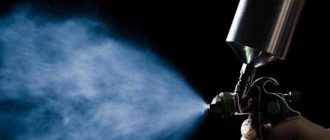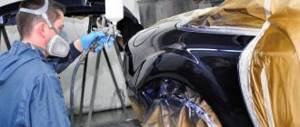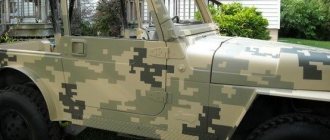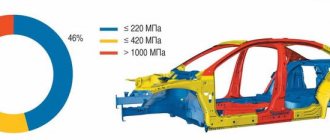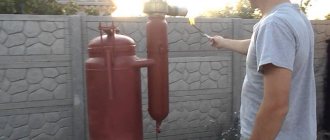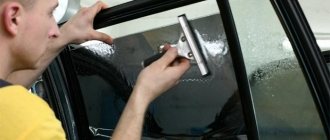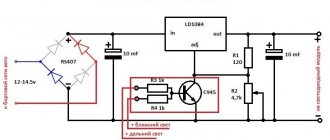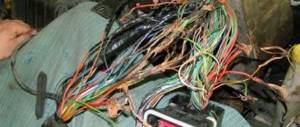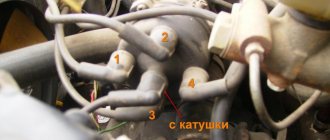What are the advantages of this painting method?
Before you spray paint your car at home, it’s a good idea to consider the practical side of the process. The method of local restoration of the paintwork of a car body has a number of undeniable advantages:
- The technology for carrying out the work does not require high qualifications.
- Varnish from an aerosol can can be easily applied to the most inaccessible places.
- There is no need for special equipment in the form of a compressor and a spray gun.
- High-quality coating is obtained even in the absence of practical experience and the low cost of the paint restoration method.
We must not forget that there are cases when the declared color may differ from the real one, so it is better to correctly calculate and purchase the required amount of paint in advance.
Main characteristics
In order to understand in more detail the scope and technology of its use, let’s get acquainted with the main characteristics. Aerosol paint got its name primarily because of the method of application. Painting is done by spraying. That is why we find paint on sale packaged in spray cans.
It is a misconception that aerosol paints have a certain composition. This is far from true. Cylinders are filled with different types of products:
- Two-component acrylic-based pigments.
- Alkyd-based enamels.
- Nitro paints.
- Paints used for temporary decoration.
- Powder coating, which is often used for local finishing.
Very often you can find original colors, such as metallic paints, chameleon coatings, primers, etc. As you can see, the choice is quite wide.
Let’s try to evaluate all the advantages of aerosol paint for metal using the following characteristics:
- The compositions are sold in cylinders that have a small volume. This brings its own conveniences. There is no need to spend extra money if you only need a little paint.
- There is no need to purchase additional tools for the coloring process. Spraying is done directly from the can. In the event that the atomizer is damaged, it can easily be replaced with another by removing it from another cylinder or purchasing a new one in the store.
- Thanks to spraying, the applied layer is quite thin, which ensures it dries quickly. In addition, paint consumption is significantly less.
- By purchasing spray paint, you can immediately start working. There is no need to waste time diluting the composition to the desired consistency or mixing shades.
On video: review of New-Ton aerosol paint.
Despite all the advantages that were given above, there are also disadvantages. These include:
- Despite the ease of application and the quality of the resulting coating, it cannot be compared with the coating that we get after working with a spray gun. If you need to get high-quality coloring, then aerosols are not suitable.
- It is not recommended to purchase paint in aerosols for painting large surfaces. Since the quality of coloring will be low. This is due to the fact that the gas reserve in the cylinders is not enough for a long time, and ultimately the uniformity of spraying is disrupted.
- The cost of dyes in cylinders is much higher compared to the same volume in a jar. For a large area you will have to purchase a lot, which entails unjustified expenses. It is difficult to refill aerosols yourself; you need to contact special workshops, which is also not cheap.
- When purchasing, be sure to pay attention to the expiration date of the material. The fact is that most aerosol cans begin to poison over time. If there is insufficient gas pressure, it will be impossible to ensure high-quality painting and use of all the substance.
Based on this, many professionals use aerosol paints only for small jobs. In this case, the benefit is obvious.
Technology: how to paint a car with an aerosol can at home without much effort?
If, upon inspection of the coating, it is discovered that the damage to the paint layer has reached the primer, or, moreover, the metal, then local touch-up cannot be avoided. It is worth noting the fact that paintwork repairs in these cases should be carried out as quickly as possible. The corrosion process goes almost unnoticed until the defect appears in a larger volume, forming a rust spot.
Preparing materials
Car enthusiasts who are interested in the question of how to paint a car themselves from a spray can should understand that the absence of the need for a compressor and a spray gun does not mean that only paint is needed for the job. Some components may not be needed, but it is still more convenient to have them on hand:
- Sandpaper.
- Degreaser, anti-silicone.
- Putty and primer.
- Aerosol with paint of the required color.
- A container of polymer varnish.
- PET film or newspapers.
You can replace antisilicone with alcohol-containing components. Don't forget about a respirator and protective clothing.
Body preparation
Using detergents, thoroughly wash the car body and let it dry. Next, we begin to work with the damaged area:
- Degrease the surface using two napkins, soak one in solvent and wipe the entire area of the planned work. Second, wipe the area dry.
- If there is rust, remove with sandpaper or chemical converters.
- Limit the work area with masking tape and PET film or paper.
- Treat the area with a primer; you can use the mixture in an aerosol can.
- Let the primer dry for 25-30 minutes and fill the defective area.
- After the putty has dried (20-30 minutes), sand it with sandpaper P350 - P400 until the body geometry is restored. Final processing is performed with abrasive P600 - P1000.
- In places where the old varnish has been transitioned, the borders should be matted with P1200 sandpaper.
- Degrease the repair surface using two napkins.
Car enthusiasts who already know how to spray paint their own car at home are advised to use a flat wooden block to secure the sandpaper.
Important! The preparation of the area for painting should cover a fairly large area relative to the repair area in order to subsequently polish the transition space.
Some nuances
The process of completely painting a car is more or less clear to most car enthusiasts. Partial car painting should take into account the spray area, it should not exceed the pre-treated area. It is necessary to ensure that the sprayed paint lies exactly along the border of the matte surface. There are a few more important points:
- An aerosol can of paint or primer should be shaken for 2-3 minutes before use.
- Preliminarily do a test painting on any unnecessary part.
- The work must be carried out in a clean and ventilated room, where the air temperature is not lower than 20°C.
- To optimize the drying process, you can use a hair dryer.
Surface preparation
If you decide to use an aerosol can as a means to remove scratches from the body of your car, then you need to know how to prepare the car body before applying enamel to the car. You can do this yourself using a certain technology. As already mentioned, there are two types of scratches, which differ only in depth and length. Of course, their processing is different.
Before you start treating the surface, it needs to be prepared. If in the first case you need to wipe the surface with a clean rag and degrease, then in the second case everything will not work out so easily. In the second case, you will need to wipe the surface, then degrease and inspect for rust on the metal of the car.
If there is rust, then everything is very difficult, because you will have to remove everything down to the metal and cover it not only with paint, but also with primer; you can do this yourself.
If there is such a scratch on the body of your car, then first of all you need to remove the layer of paint yourself, down to the metal itself, and then treat it all with a special primer that will prevent the rusting process from occurring. Then you need to wait until the primer dries, and only after that you can start painting the car body. All this can be done without much effort with your own hands, if you read everything and act correctly, and not at the moment when you already need to redo everything.
Main stages: how to paint and spray-varnish a car yourself in a garage?
The technology of spray painting a car is not particularly difficult. A container of enamel is sprayed from a distance of 250-300 mm, the number of layers is two or three. Each layer needs to be thoroughly dried for 15-20 minutes. Thus, painting activities can be divided into several stages:
- Before you paint your car yourself using an aerosol can, you need to shake it thoroughly for 2-3 minutes and apply the first coat. The last layer dries for 30-40 minutes.
- After applying two or three layers of paint and control drying, a transparent varnish is applied. The technology is the same as when working with enamel - the varnish is applied in 2-3 layers.
- In the final stage, you need to blur the boundaries of the transition between the old and fresh coatings using an aerosol solvent. Only the transition area should be sprayed.
Polishing or transition processing
There are two polishing methods: abrasive and protective. The mechanism of the first method is to eliminate unevenness in a thin layer of varnish 2-4 microns thick due to small abrasive particles contained in the paste-like material. The average thickness of the varnish is 35-40 microns, so it can withstand 5-7 abrasive treatments without damaging the paint.
Protective polishing is the final stage after painting. Here, micro-scratches left behind by the abrasive are removed and a thin protective layer is created. Both methods are also applicable after painting car parts made of plastic and metal. Car cosmetics manufacturers offer two types of protective polish
- Wax based, withstands 5-6 washes.
- Teflon based, withstands 10-12 washes.
Pastes based on UV-20 and Teflon are more expensive, but are durable and effectively protect the varnish from the effects of acids, alkalis and ultraviolet rays.
The polishing material is applied to the body in a small amount, after which the polish is rubbed with a suede rag. A uniform layer is maintained for 3-5 minutes, during which it dries and acquires a light matte color. Motorists who thoroughly know how to paint a car with an aerosol can at home prefer to use a polishing machine. At the same time, they recommend experimentally setting the disk rotation speed and taking short breaks in work, avoiding overheating of the paintwork.
If the paint has a dark color, then sanding should begin with P2500 sandpaper. Next, slightly moisten the surface of the body and the pad of the polishing wheel, apply the paste and rub over the area at about 1000 rpm. Then increase the speed to 1500 and bring the paintwork to a glossy shine. Periodically, the paste should be moistened, but carefully so as not to splash adjacent areas of the body.
How long does it take for car spray paint to dry?
Aerosol varnish forms a coating that protects the surface from exposure to ultraviolet radiation and weather conditions. Some compositions give the product a glossy, 3D effect. The varnish is applied over all layers after they have dried.
There is also a technology that allows you to speed up the drying process of the varnish coating: spray the composition, heating the varnish aerosol to 70°C, onto a surface heated to +10°C.
The exception is the drying of the varnish film applied to metallic enamel. In this case, it is not recommended to reduce the drying time, so as not to cause a lack of adhesion between the metallic enamel and the varnish. The degree of drying is determined by lightly touching your finger: if the varnish is not smeared, then apply the next layer.
Read further:
Paint consumption per 1 m2: for walls with different textures, depending on the method of application, examples of calculations
Drying time for car paint
Choosing paint in a spray can for painting a car: main problems and methods for choosing the composition
Pay attention to: How and with what to paint a leather bag?
What to do to speed up paint drying: various techniques to speed up drying time
How to paint car rims with a spray can yourself: features of self-processing
